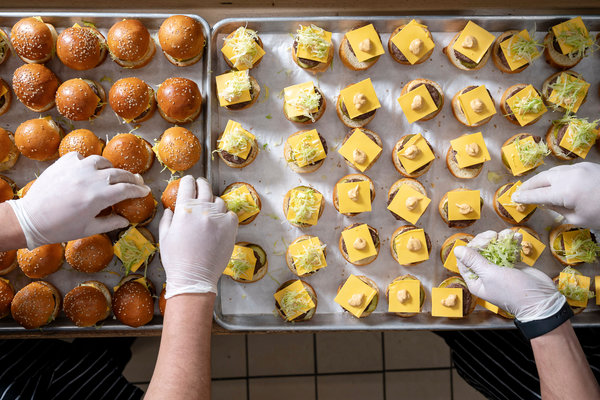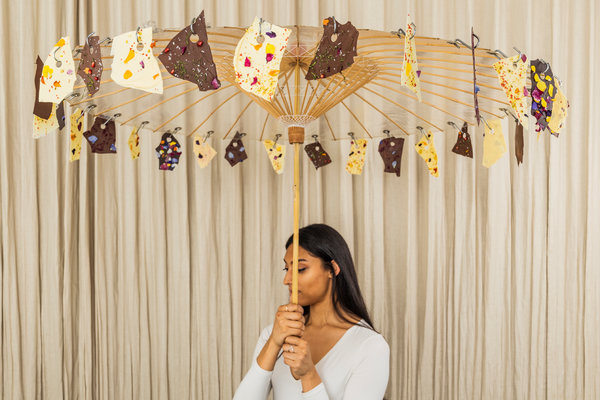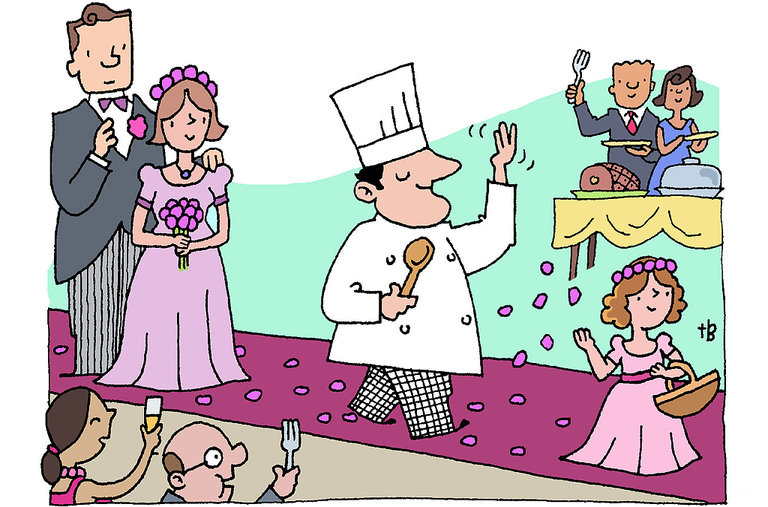One June night in 2011, the food-writing brothers Matt and Ted Lee showed up to support a fellow Southerner who was cooking at the James Beard House.
The 1840s brick townhouse in Greenwich Village where Beard once lived is a showplace for chefs looking for validation from the foundation that runs it. But it’s a notoriously stressful place to cook. The kitchen is hot and small, with limited access for prepping food. If you screw up in front of the influential guests, a shot at a national reputation can be dashed before dessert is served.
Their friend, the chef Steven Satterfield of Miller Union restaurant in Atlanta, had to knock out 80 servings each of sautéed quail and braised oxtail crépinette, delicate dishes that can overcook in a minute. So he enlisted help from three of the best catering cooks in the city. As the Lee brothers watched, they unzipped their backpacks, unrolled the dish towels that held their knives and attacked the kitchen like Navy SEALs swarming a ship commandeered by Somali pirates.

The idea for the book was born when the Lee brothers showed up to watch the chef Steven Satterfield (above, at his Atlanta restaurant, Miller Union) cook a special dinner at the James Beard House in New York.CreditRaymond McCrea Jones for The New York Times
Later that night over drinks, the catering cooks said the dinner had been as easy as rolling out of bed. Try cooking 1,400 lamb chops to a perfect medium-rare at the same time, using nothing but sheet pans, Sterno and an upright aluminum cabinet on wheels called a hot box.
[Learn how to talk like a caterer.]
The Lees, who until that point considered catering the elevator music of the culinary arts, found themselves falling into a rabbit hole that would consume them for the next four years.
They went undercover as catering cooks, and their dive into the world of mercenaries who work the fanciest parties in town has produced the new book “Hotbox: Inside Catering, the Food World’s Riskiest Business” (Henry Holt & Company, 2019). It’s a revelatory, detail-rich and often breathless examination of a cutthroat world where the demanding clients include billionaires and celebrity brides but the cooking conditions resemble a mobile Army hospital.
The subject is a ripe one. A $12 billion-dollar-a-year industry in the United States, catering is rarely examined by food journalists or considered by diners, who are more focused on restaurants. Its influence is quiet but powerful. If you’ve ever had a miniature lobster roll, or sipped soup from a shot glass at a party, or attended a pop-up dinner, you can thank a caterer.
Nowhere is catering practiced with as much cunning and challenge as in New York City. On any given week — and especially during the wedding and gala seasons — hundreds of thousands of people eat food cooked by caterers.
Sometimes the meals are as low-stakes as a snack between sessions at a mind-numbing conference. Other times, a badly prepared $2,000-a-plate meal can hurt a charity that hoped to open wallets over short ribs with horseradish cream.
It’s astonishing that the business doesn’t get the attention or respect afforded restaurants, the Lees write, “considering all that these catering chefs are up against and regularly conquer — their nerve-rattling tightrope sprints through A-list celebrity territory, the exquisite food torture, a season’s worth of MacGyver-y kitchen rescues that throw propriety, food safety, and convention out the door because ‘we have to make this work right now!’”
The book is a departure for the Lee brothers, whose previous titles have been cookbooks, and whose other ventures include a Southern-food-of-the-month club, television work and, since 2013, a bespoke catering business in partnership with Duvall, an event planner in Charleston, S.C., where the two grew up.
Ted Lee, 47, lives in Brooklyn with his wife, the artist E.V. Day. Matt Lee, 49, is raising three sons in Charleston with his wife, Gia Lee, a schoolteacher and real-estate agent.
In some ways, the brothers were primed for the task. From 2004 to 2006, they wrote a column for The New York Times Magazine called The Industry, in which they spent time with produce buyers, cake movers and other unsung restaurant workers.
“Hotbox” was also a chance to get off the cookbook conveyor belt.
“We were at a pivot point,” Ted Lee said. “How much more does the world need to hear from two white guys who grew up in Charleston in the 1980s about how they cook?”
To immerse themselves in the catering business, they persuaded Patrick Phelan, then the executive chef of the upscale New York caterer Sonnier & Castle and one of the chefs who swooped in to help Mr. Satterfield, to hire them.
Taking turns, they worked for $10 an hour in the prep kitchen or for $25 an hour during the event — what in catering parlance is called the fiesta shift, when time is a cruel overlord and small mistakes have huge implications.
The book explores their struggles to build 240 pepper-crusted beef-on-brioche snacks with celery root salad for the Park Avenue Armory gala in 2015, or peel 800 hard-boiled eggs to help Royal Caribbean cruises introduce a new line of restaurants to 1,400 guests. They handed hot Cafe du Monde beignets to Nancy Pelosi before she became speaker of the House, and grilled hot dogs to Martha Stewart at a $1.5 million Labor Day party in the Hamptons.
The brothers became enamored of the tricks of the trade, which insiders refer to as “sheet-pan magic.” Did someone forget the colanders back at the main kitchen? Use a ballpoint pen to punch holes in the bottom of an aluminum foil pan. In a pinch, two metal hangers from the coat check can be fashioned into a whisk.
Commandeer a woven bread basket if you can’t find any other way to dust 500 chocolate mousse cups with powdered sugar. And if a drunken uncle’s wedding speech is dragging on too long, you’d better figure out a way to keep the salmon warm without overcooking it.
Their teachers through much of the journey were Jorge and Juan Soto, brothers from Mexico whom they met that night at the Beard House. The Sotos are masters of the hot box, the wheeled cabinet, with racks perfectly sized to hold sheet pans, that is the secret to New York catering.
The boxes are meant to transport food, not cook it. But in New York, which restricts the use of propane and open flame, the boxes are deployed as bootleg ovens. With enough cans of Sterno and strategically placed sheet pans, a good catering chef can bring hundreds of rare filets mignons that had been browned in a deep-fat fryer back at the prep kitchen to temperature in a back room at the New York Public Library or the Whitney Museum of American Art.
Conversely, fill a tray with dry ice, and the box can become an instant refrigerator.
“It’s an insanely analog system,” they write, “a bit like piloting a hot air balloon, but it’s ruthlessly efficient, self-contained, safe, scalable, and cost-effective to run.”
The Lees credit Jean-Claude Nédélec with inventing the hot-box system. Mr. Nédélec developed it and other essential pieces of off-site catering stagecraft when he was the banquet chef at the Plaza Hotel in the 1960s. He went on to become the executive chef at Glorious Food, a catering company that started in an apartment on 48th Street in the 1970s and dominated New York catering for two decades.
But it was Donald Bruce White — a former Broadway actor who began his food career as a bit player on “Josie’s Kitchen,” a local cooking show that predated Julia Child’s “The French Chef” — who created the city’s modern catering industry in 1962, the Lees report.
In what seems a foreshadowing of Uber Eats, Mr. White started delivering same-day meals ordered by telephone. Soon, he was directing entire parties in Park Avenue apartments.
By the 1970s, New York was a city that loved catering. Martha Stewart jumped into the game, as did the powerhouse caterer Liz Neumark of Great Performances.
By the 1980s, caterers had become full-fledged event planners, and their parties were as flashy as the decade. Charities began to use galas as fund-raising opportunities. Institutions like the Metropolitan Opera realized there was money to be made renting out space for lavish events. Casting cater waiters became an industry unto itself.
By the 1990s, a new age of restaurant culture had dawned, and catering customers were demanding restaurant-quality food. Chefs like Daniel Boulud jumped into the game, but plenty of others realized it was one they didn’t like playing.
“The way that a caterer thinks about feeding people in a large group setting is not the same as the way a chef thinks about it,” Mr. Satterfield said in an interview. “You need that catering mind.”
The chef Bobby Flay told the Lees that when he opened a catering division of his Mesa Grill restaurant group around 1997, it “was the worst year of my life.”
The Instagram era has brought a new level of performance to catered food, with meringues floating through parties suspended under white balloons, and waiters pedaling raw bars fashioned from wheelbarrows and bicycles. Tech and finance billionaires have raised the ante, too. One client, the Lee brothers report, regularly pays a young caterer to smuggle poulet de Bresse chickens from Paris on a Gulfstream jet at $200,000 a trip.
It’s also an era of ultra-customization, which is the antithesis of catering. Couples don’t want a traditional fairy-tale wedding, they want a tale that’s never been told, the Lees write. Caterers are handed elaborate and often confusing menus that are meaningful to the couple but daunting to execute.
The biggest headaches for modern caterers, the brothers posit, are food preferences and intolerances dressed in food-allergy drag. The elaborate assembly-line system designed to deliver hundreds of perfect plates in a 15-minute window is getting gummed up with special requests. Waiters face a barrage of questions from guests who want to know whether the main course contains soy or nightshades, or if the vegetarian option is laced with dairy.
“Every clever caterer nowadays packs a pile of washed salad greens, a soy-free dressing, and a sheet pan of dry-grilled vegetables for occasions when it’s just impossible to make that one person happy,” they write.
A nice side effect of the brothers’ time in the trenches is that they have become better home cooks. Throwing a dinner party for 10, once a stressful proposition, is a breeze.
Their kitchens are better organized before and during a party, and they’ve started using the building blocks of a good catering kitchen: square, stackable Cambro containers and small plastic deli tubs. They’ve also become more comfortable making food ahead of time, and don’t worry about whether it’s kept at the absolute safest temperature.
“We are so much more confident now because we’ve seen what’s possible on a huge scale,” Matt Lee said.
And they’ve become better guests at catered events. When the cocktail hour ends and the chime rings for everyone to take their seats, they do.
“When the service captain tells you sit, stop talking and sit,” Ted Lee said. “It’s critical. The quality of the salmon is at stake.”










